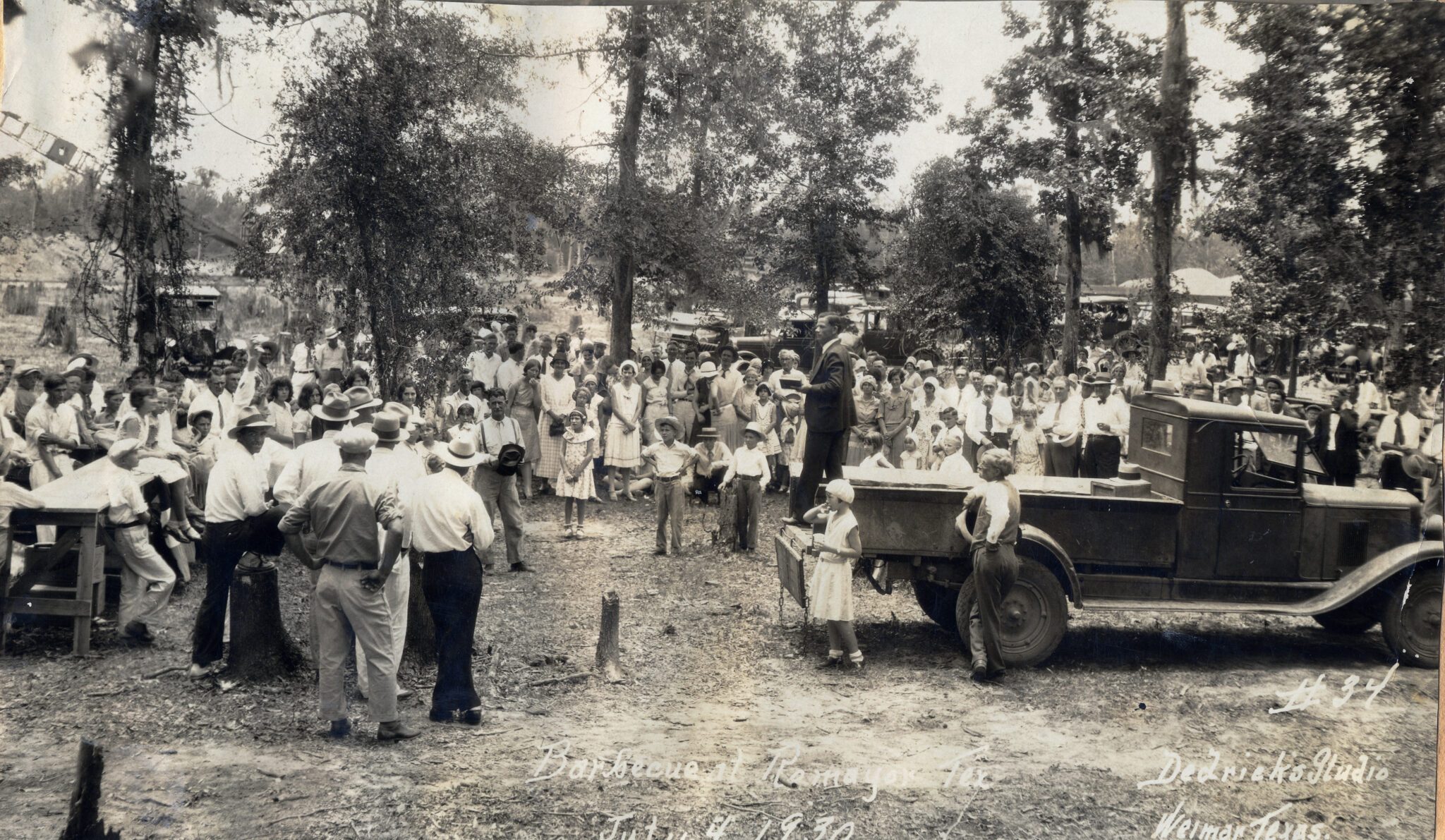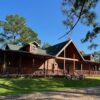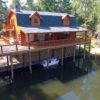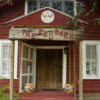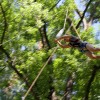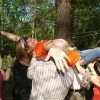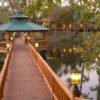We are celebrating 50 years as a Family-Owned and Operated Business!
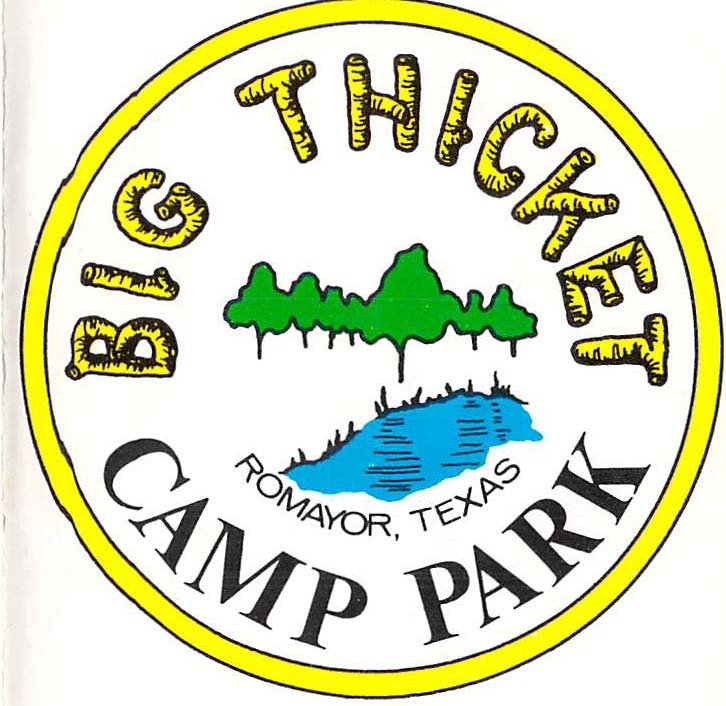
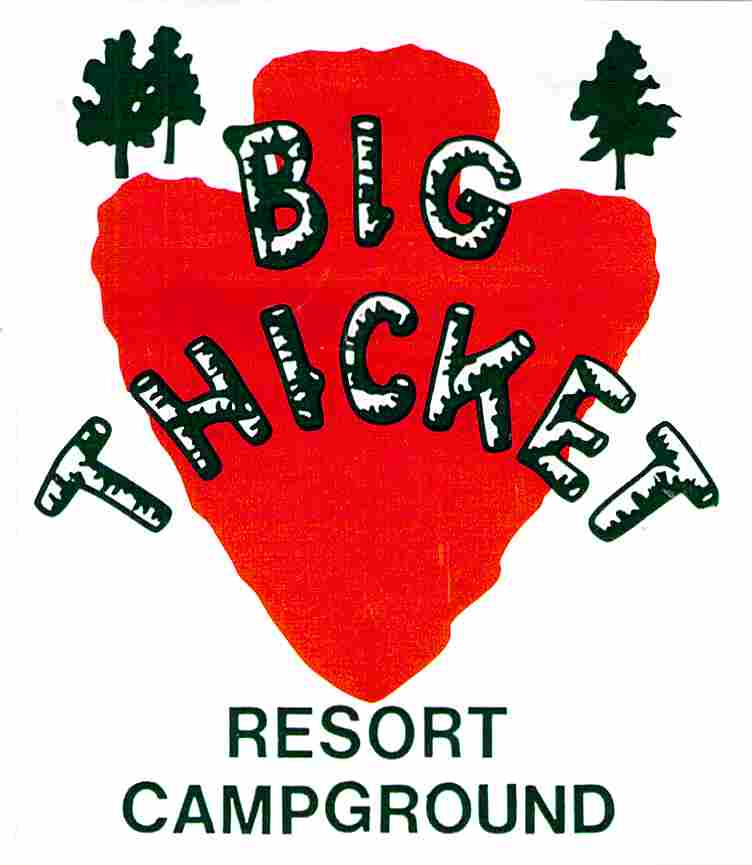
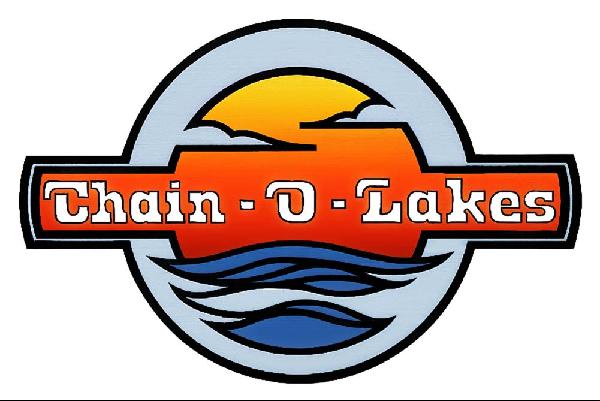

1969
1974
1982
1998
Every so often, across this great and bountiful country, Mother Nature is especially kind to a certain small slice of her landscape. These special places are distinguished by their visual or geological esthetics as well as an intangible “energy” or “feel” about them. The Retreat at Artesian Lakes is such a place, and for over a century has served as a retreat for outdoor and nature enthusiasts, a special place for respite and rejuvenation.
The story begins eons ago when this land was in the center of an “ox-bow” of the Trinity River for many thousands of years. What this means is that the river made a sharp 180° reversal of its direction; literally a u-turn. When heavy rains upriver caused flooding, the swollen waters would create a circular swirling action to the river within this arena. In the center of this circular course of the mighty Trinity, heavier objects of all kinds were precipitated. I even found a mammoth tooth here about thirty years ago. The net effect of this cycle over the eons is that layer upon layer of gravel, petrified wood, and sand were deposited here to a depth of several hundred feet.
The 500 acres that today comprise Artesian Lakes attracted the attention of natural resource entrepreneurs in the late 1800’s, for these rich gravel deposits. The building boom in Houston and Beaumont created an insatiable hunger for a fantastic new construction material incorporating gravel as a major component – concrete.
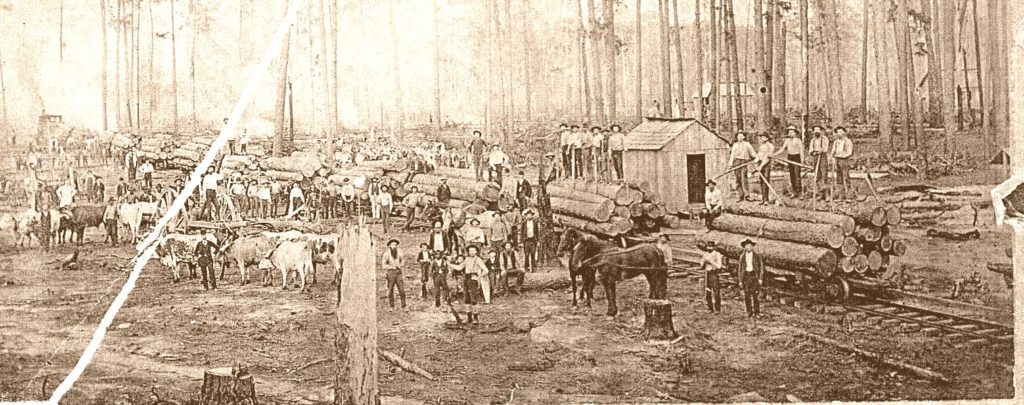
1900 Logging that preceded gravel excavation
Most of the timber was harvested from these 500 acres before the gravel excavation began – gigantic virgin pine and hardwood – while the land encircling this acreage was acquired by the Kirby lumber dynasty as part of its resource supply. The remains of a double-axle locomotive, intended for use on the hastily constructed rail lines laid for hauling timber, resided for many decades on Train Island. Built in 1895 in Lac La Belle, Michigan, it is the oldest wood burning, inclined-cylinder Climax Model B locomotive in existence, and is quite a celebrity among railroad enthusiasts.
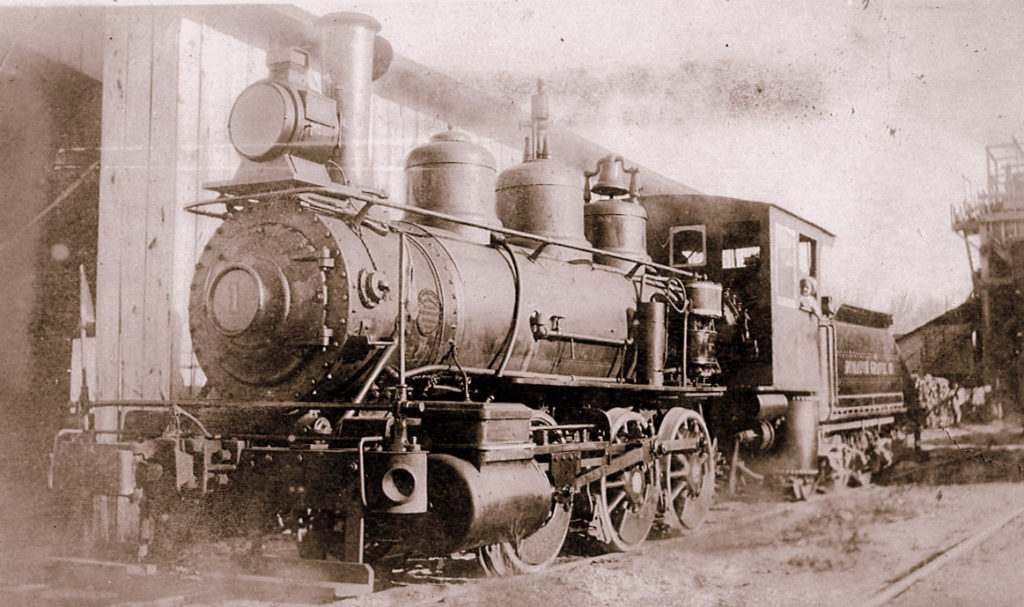
Climax Model B locomotive
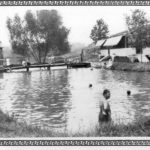
The Lodge – 1900
In 1900, a large “Lodge” was built by one of the first mayors of Beaumont as a summer retreat. He is credited with giving the region its name: Chain-O-Lakes. As the Texas Construction Materials (TCM) gravel excavations expanded in the early 1900’s, this facility housed the superintendent and his family and served as the dining hall and community center. It featured large screened porches where visitors and company executives slept when they came to check on the growing mining operation.
During these early years, both shallow and deep-water wells were drilled to supply the copious quantities of water used in the process of “washing,” separating and grading the gravel. It quickly became obvious that the aquifer underlying this land in the center of this ancient “ox-bow” of the Trinity River was the most remarkable in the entire state.
An artesian well is a rare and wonderful type of water well that requires no pump to bring the water to the surface. There is enough pressure pushing the water up out of the aquifer through the pipe that it flows on its own – without being pumped. There are five of these at The Retreat at Artesian Lakes, and some of them have enough pressure behind them to flow 20 or 30 feet above ground level. Each of them is capable of producing several hundred thousand gallons of the purest and best-balanced mineral waters in Texas every day. Beyond our modest needs for our public water supply system, these artesian wells and natural springs supply the lakes.
This clear, flowing water combined with the tall East Texas pines and many varieties of hardwoods that cover the terrain and hills between the lakes is what creates the panoramic views that have earned us the title “Crown Jewel of East Texas” from the East Texas Chamber of Commerce.
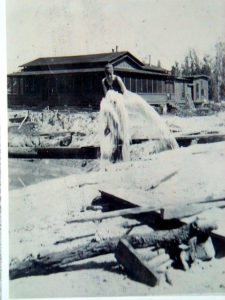
Laura Beesley atop Artesian Well – circa 1930
Since there was an abundance of artesian water and gravel, a “swimming hole” with concrete sides and gravel bottom was built at The Lodge, perhaps the first swimming pool in Texas. Both the early Lodge and this early swimming pool remain as silent testament to the good times had there.
The “gravel pits,” as it was called, became a sizeable industry complete with dozens of employees living on site and two steam engines, named Peggy and Marie, to transport draglines and the railcars of gravel around the operation. My father remembers well the “company store” and a thriving community that resembled a California mining camp. One of the highlights of his youth was watching the rail cars being unloaded with such incredible novelties as large chunks of ice for refrigeration.
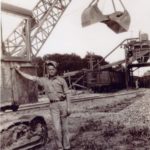
Herb Waterhouse
In 1920, a gentleman with Beaumont Building Co. arrived named Tom Beesley. In 1932, he negotiated the sale of the property from the McDonald family to TCM. In 1939 my aunt, Mark Biggs, acquired 170 acres of the property from TCM and in 1947, the Beesley family purchased this “town” and the remaining acreage. The Beesley family continued to excavate gravel and coarse sand until the early 1980’s.
During the 1940’s through the 1960’s, Mark and Jack Biggs (my aunt and uncle) operated their part of the property (whose gravel and sand excavation was completed, leaving many interconnected lakes) as a “fishing camp” and company retreat for Magnolia, Eastern States, Signal, and later, Charter Oil Companies. During this period, club members built several of the older cabins and a brick house.
In 1946, my parents spent their honeymoon in one of those cabins, which still stands near our organic farm, Clearwater Farm. As a child, I spent many wonderful days and nights here, being taught by various relatives about the outdoors and especially this unique slice of nature. I still remember watching bears ramble through the pines in the early morning light. There was a fish fry or Uncle Jack’s famous “squirrel mulligan” and biscuits for supper almost every night. We would pretend not to notice the bottles of Jim Beam the following morning.
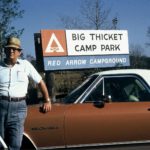
James D Smith Sr.
In 1969, the property was acquired by my father, Dr. J.D. Smith, Sr. and developed as Big Thicket Camp Park. My brothers and I provided the cheap labor force for construction of the first basic facilities, as this became an ongoing family project —- and I do mean ongoing… During those years my father and master craftsmen like Leon Culbertson taught me a great deal about construction.
In 1971, while I headed for dental school, my father leased the property to a couple that managed the business for 12 years as Big Thicket Resort Campground, at times also called “Red Arrow.” My father continued to make all capital improvements, using his sons and others to execute his construction plans, including what became “home” for all of us, the present site of Hilltop Restaurant.
In April of 1977, after a Dental General Practice Residency and tour of duty in the Air Force, I returned to this area with my young family. In February of 1983, my father and I purchased another 102 acres of the original 500 acres from Mrs. Beesley. In keeping with the new image we wanted to project, I obtained permission from her and her two daughters, Ray Lebr and Laura Hudgins, to use the old name that had applied to the whole area at the turn of the century: Chain-O-Lakes.
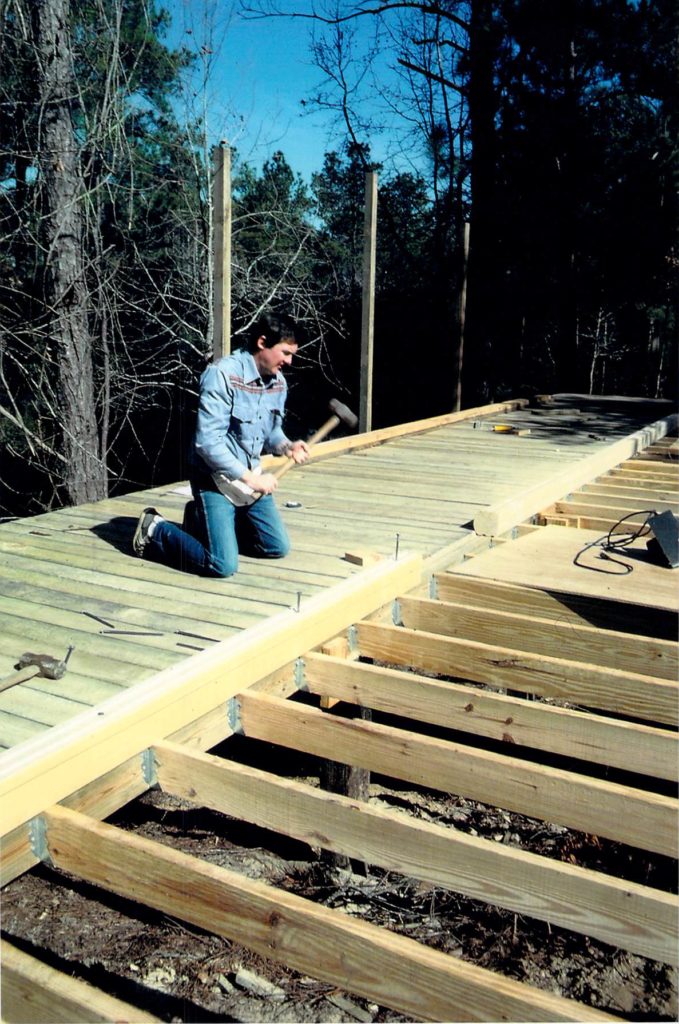
James D Smith Jr – First Nail in First Log Cabin – Winter 1985
In February of 1984 I bought out the interests of the rest of the family and launched an ambitious new construction phase. The first log cabin was built in the winter of 1985 and was a huge success. My 11 year old son, Wyatt, began his many years of involvement handling garbage collection within the facility.
The next 14 years were spent dreaming and building the young enterprise. By the end of 1986, we had constructed 14 lakeside bed-and-breakfast log cabins and a 14,000 square-foot lodge, which included dormitory accommodations and meeting facilities. In 1987, the renowned Hilltop Herb Farm was acquired and moved to Chain-O-Lakes from its previous location west of Cleveland, Texas. All of the equipment, recipes, staff, and extensive plant collection were relocated to what had previously been my parent’s home, Cardinal Ridge. Their touch is still apparent in the central dining room, with its fireplace and cedar beams. This was their living room. And in the Maple Room, which was their bedroom and study. Ever since, Hilltop has continued to please the palates of discerning diners with its exquisite menus prepared with fresh ingredients and herbs from the adjacent garden.
The next year, 1988, the business was booming, and the resort was drawing over 150,000 people annually, mostly weekend campers and day visitors. By 1992, we had completed a total of 27 log cabins and The State of Texas Tourism Division dubbed Chain-O-Lakes the “Best Least Known Resort”. In 1993, the Hilltop restaurant and meeting room complex was expanded from its original 2,200 square feet to a 10,000 sq. ft. building with a meeting room accommodating up to 80 guests.
During the 1990’s, an increasing number of corporate clients began using the facilities for team-building, leadership, and strategic-planning retreats. In the mid-1990’s I began to phase out my dental practice in Humble in order to devote full attention to designing and facilitating these retreats and to overseeing construction of additional facilities. My daughter, Stacy, joined the company starting at the bottom of the organizational chart. When she left for an urban environment, she was general manager, after working in almost every department.
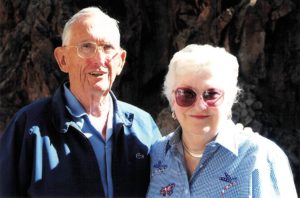
Doc and Norma Smith
One of the outstanding events of the 1990’s was Mom and Dad’s Golden Wedding Anniversary party in 1996. What a huge role they have played in the history of this special place!
By 2002 we had expanded to 32 log cabins and built a grand new facility named The Hospitality House. In addition, we acquired the balance of the original 500 acres from the daughters of Tom and Jessie Beesley, restoring the property to its original boundaries of 100 years ago. Four Hundred of these acres comprises the nature-focused subdivision Artesian Lakes. For the sake of continuity, we changed the name of the resort from Chain-O-Lakes to The Retreat at Artesian Lakes.
Over the years, the Smith family has continued to act in the capacity of steward in carefully developing and preserving this natural resource for the soul in keeping with the words of Chief Seattle: “We did not inherit the earth from our forefathers, we are borrowing it from our children.” My wife Helena was General Manager for several years, and still contributes to our marketing efforts. Wyatt is now the resort’s General Manager. That title includes every task imaginable in a family-operated business, such as this water system repair at 4 AM.
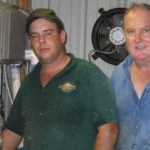
Repairing Water System at 4 a.m. 2005
And so… a fourth generation of Smiths enters its 50th year serving our loyal guests who visit from as far away as the Netherlands. Wyatt recently completed construction of his home within the resort, where he lives with his three children (and our grandchildren). With them, a fifth generation of Smiths is being raised in this unique setting, enjoying and cherishing nature. Hopefully, they will continue the family tradition and guide The Retreat at Artesian Lakes into an even brighter future.
We have indeed come full circle in the century of history this hospitality enterprise has enjoyed. The land has been restored to its original 500 acre 1915 configuration and many old purposes are being introduced in new forms. An example would be the catch¬and-release bass fishing club and intensive lake management program underway. Another would be the success of Wyatt and his crew in moving the old locomotive – the oldest of its kind remaining – from the island it called home for 80 or 90 years.
In keeping with the expressed desires of you, our valued guests who return to us with great regularity, we continue to upgrade the “creature comforts” of our accommodations and cuisine to enhance your interlude in the great outdoors. We really do subscribe to the philosophy of excellent service and gracious Southern hospitality.
The Smith family and each and every member of our extraordinary staff, invite you to consider The Retreat at Artesian Lakes as your place in the country. A place to Retreat Yourself…
Dr. James D. Smith Owner

